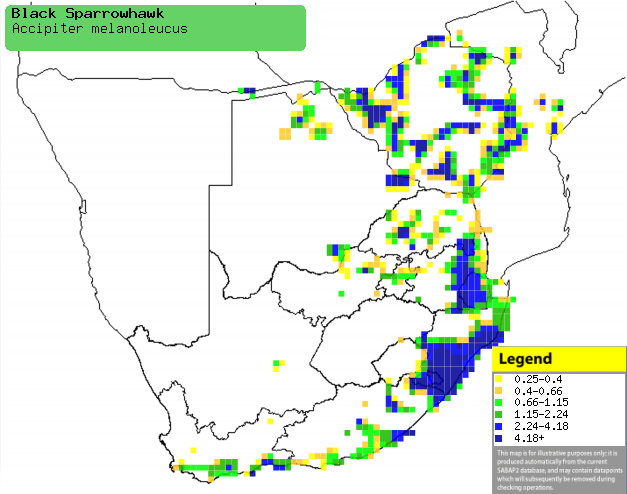|
Accipiter melanoleucus (Black
sparrowhawk)
Swartsperwer [Afrikaans]; Kakodi (generic term for
sparrowhawks, goshawks, kestrels and falcons) [Kwangali]; Rukodzi (generic
name for a small raptor such as falcon or sparrowhawk) [Shona]; Zwarte
havik [Dutch]; Autour noir [French]; Mohrenhabicht, Trauerhabicht
[German]; Açor-preto [Portuguese]
Life
> Eukaryotes >
Opisthokonta
> Metazoa (animals) >
Bilateria >
Deuterostomia > Chordata >
Craniata > Vertebrata (vertebrates) > Gnathostomata (jawed
vertebrates) > Teleostomi (teleost fish) > Osteichthyes (bony fish) > Class:
Sarcopterygii (lobe-finned
fish) > Stegocephalia (terrestrial
vertebrates) > Tetrapoda
(four-legged vertebrates) > Reptiliomorpha > Amniota >
Reptilia (reptiles) >
Romeriida > Diapsida > Archosauromorpha > Archosauria >
Dinosauria
(dinosaurs) > Saurischia > Theropoda (bipedal predatory dinosaurs) >
Coelurosauria > Maniraptora > Aves
(birds) > Order: Falconiformes
> Family: Accipitridae
> Genus: Accipiter
Distribution and habitat
Occurs in patches of sub-Saharan Africa; in southern Africa it is scarce to fairly common in
Zimbabwe, northern and eastern Botswana, the Caprivi Strip (Namibia), central
Mozambique and South Africa. It generally favours forest and
well-developed woodland, such as Kloof and riverine forest, Acacia
savanna and miombo (Brachystegia) woodland; it may also occupy grassland,
fynbos, fringes of the Karoo, agricultural land and suburbia.
|
 |
|
Distribution of Black sparrowhawk in southern Africa,
based on statistical smoothing of the records from first SA Bird Atlas
Project (©
Animal Demography unit, University of
Cape Town; smoothing by Birgit Erni and Francesca Little). Colours range
from dark blue (most common) through to yellow (least common).
See here for the latest distribution
from the SABAP2. |
Movements and migrations
Largely sedentary, although some records
outside of its normal distribution range suggests that it may be
nomadic at times.
Food
It almost exclusively eats other birds, doing most of its
hunting under the tree canopy, often catching prey from a concealed perch. It
may pursue a bird for over a kilometre before making the kill; it has even been
recorded to be cannibalistic! The following food items have been recorded
in its diet:
Breeding
- Monogamous, territorial solitary nester, performing a courtship display in
which it calls loudly while in an undulating flight.
- The nest is built by both sexes about 50-145 days before egg-laying,
consisting of platform of sticks with an interior cup, which is thickly lined with green leaves,
especially of Eucalyptus, Bushmans-tea (Catha edulis), Red-milkwood
(Mimusops zeyheri), waterberries (Syzygium), Horn-pod tree (Diplorhynchus
condylocarpon) and Musasa (Brachystegia spiciformis). It is
typically placed in a fork of a tree branch in or just below the canopy. It
has been recorded to use the following sites for breeding:
- alien trees (used in roughly 65-90% of breeding attempts)
- Eucalyptus
- Populus (poplars)
- Pinus (pines)
- indigenous trees
- Adansonia digitata (Baobab)
- Acacia
- A. robusta (River thorn)
- A. nigrescens (Knob thorn)
- A. galpinii (Monkey acacia)
- Brachystegia glaucescens (Mountain-acacia)
- Kirkia acuminata (White kirkia)
- Anthocleista grandiflora (Forest big-leaf)
- Avicennia marina (White mangrove)
- Celtis africana (White-stinkwood)
- Celtis mildbraedii (Red-fruit white-stinkwood)
- Ekebergia capensis (Cape-ash)
- Erythrina caffra (Coast coral-tree)
- Ficus natalensis (Coastal strangler fig)
- Ficus sycomorus (Sycomore fig)
- Ilex mitis (African holly)
- Philenoptera sutherlandii (Forest apple-leaf)
- Olea europaea (African olive)
- Podocarpus latifolius (River bushwillow)
- Syzygium (waterberries)
- Trichilia emetica (Natal-mahogany)
- Trichilia dregeana (Forest natal-mahogany)
- Euphorbia ingens (Giant euphorbia)
- nests of other birds (instead of building its own)
- Egg-laying season is from March-December, peaking twice in the Western
Cape, from April-May and from August-September, while elsewhere it peaks from
July-September.
- It lays 1-4 eggs, which are mainly incubated by the female for about
36-38 days, while the male feeds her regularly at the nest.
- The chicks are brooded by the female for the first 22 days of their
lives, after which she starts to join the male on hunting trips. The chicks start clambering around the nest tree at
approximately 35-40 days old, leaving completely roughly 2-10 days later.
They remain dependent on their parents for further 42-60 days, after which
the adults leave the area, thus forcing their young to become fully
independent.
Threats
Not threatened, in fact its range and population have
increased due to the spread of alien trees, which it commonly uses as nest
sites. It is frequently killed because of its tendency to hunt homing pigeons and
poultry, but this practice does not seem to be seriously impacting its numbers yet.
References
-
Hockey PAR, Dean WRJ and Ryan PG 2005. Roberts
- Birds of southern Africa, VIIth ed. The Trustees of the John Voelcker
Bird Book Fund, Cape Town.
|
